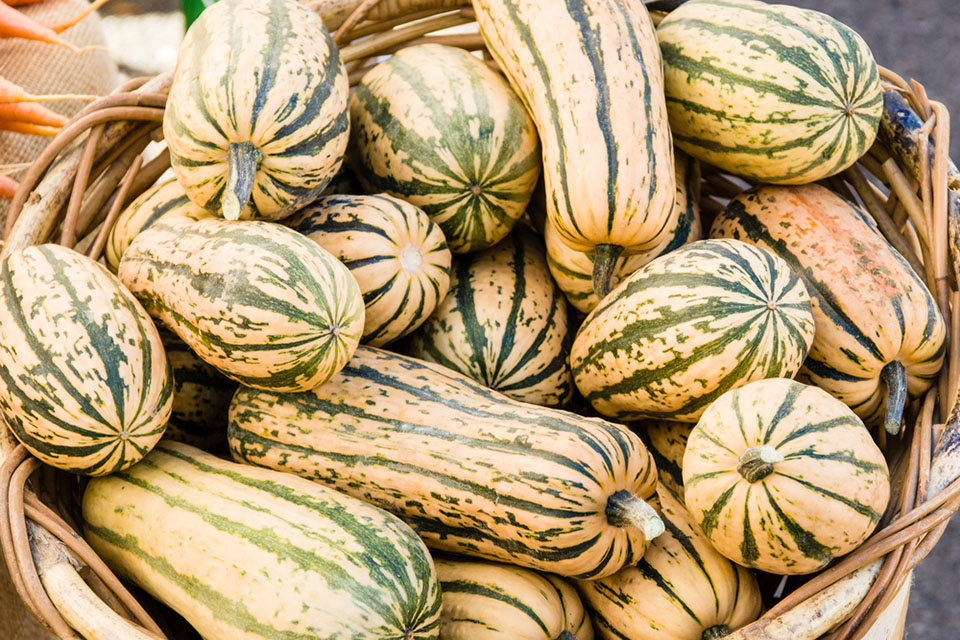Delicata Squash: I Can’t Believe It’s Not Butternut
Try delicata, an heirloom squash experiencing a dramatic revival thanks to the richer flavor and softer skin of a productive variety that first hit seed markets about a decade ago.
Delicata Squash: I Can’t Believe It’s Not Butternut
Try delicata, an heirloom squash experiencing a dramatic revival thanks to the richer flavor and softer skin of a productive variety that first hit seed markets about a decade ago.

This fall, there is a way to avoid the butternut sinkhole. Try delicata, an heirloom squash experiencing a dramatic revival thanks to the richer flavor and softer skin of a productive variety that first hit seed markets about a decade ago.
Technically a summer squash (Cucurbita pepo), delicata is generally classed with winter squash because it is hard-fleshed and harvested late in the year, but boasts summer squash skin, which is tender enough to remove easily with a vegetable peeler. Also known as “sweet potato squash” for its brown sugar flavor, delicata tastes like a cross between fresh corn and pumpkin pie. Like all hard squash, delicata is high in beta-carotene and vitamin C, relatively low in calories and astonishingly versatile.
With a name like delicata, though, it must be hard to grow, right? Not so.
With a name like delicata, though, it must be hard to grow, right? Not so. Plant it in the summer, and the squash will be ready to harvest after 80 to 100 days in full sun, when the cream-colored skin begins to develop irregular dark-green stripes, like someone has painted the vegetable with an unsteady hand. Unfortunately, delicata is less hardy than other varieties; whereas butternut may be stored up to a year, delicata keeps for just two to three months in a cool, dry place. As delicata ages, the skin develops a deeper orange hue between the stripes, so look for squash with light-colored skin that’s relatively heavy for its size. In general, steer clear of any winter squash that is soft or wrinkled.
According to Kerry Gawalt, owner of Cedar Mountain Farm in Vermont, delicata squash should be harvested in the fall, cured in a warm spot for two weeks, inspected for cuts and then wiped with a mild Clorox solution. “We then store the squash in a 55- to 60-degree room until December,” she says.
First introduced in 1894, the delicata has a shorter shelf life – and smaller yield – that made it less commercially viable than hardier winter squash like butternut, and as a result, delicata was nearly lost during the Great Depression. When scientists at Cornell University bred a more compact, disease-resistant bush variety about 10 years ago, delicata began making a comeback. Now, it is much more widely available at farmers markets, where its flavor has inspired die-hard devotion.
So, welcome back, delicata! Consider the butternut oligarchy squashed.


This recipe is adapted from a dish served at the San Francisco restaurant Bar Tartine, where chef Nicolaus Balla tops roasted and pureed butternut squash with sunflower sprouts, curried yogurt, cilantro puree, and pomegranate molasses. The toppings suggested here are somewhat simpler – creativity is encouraged. This recipe serves a crowd, but freezes well. Yield: 5 to 6 cups.
Preheat the oven to 350 F. Cut squash in half and remove seeds. Rub flesh with 2 tablespoons olive oil and 2 generous pinches salt.
Place squash cut side down in roasting pan and bake until very soft, about 1 hour.
While squash is baking, place garlic, serranos and remaining olive oil in small pot over low heat. Poach garlic and peppers in oil until completely soft (30 to 40 minutes). Garlic should be very lightly browned.
Scoop out flesh from roasted squash and place in food processor. Add garlic-poaching olive oil, garlic, serranos, tahini and lemon juice. Puree until smooth, about 1 minute. Season to taste with salt and pepper.
Hummus texture will vary depending on squash variety and size; add up to ½ cup water until desired consistency is reached. Refrigerate for at least 3 hours and up to 1 week.
For 1 cup hummus, garnish with ¼ cup yogurt, 1 tablespoon pumpkin seeds and sprinkling of cilantro leaves. Serve with crusty bread, pita or crackers.
Follow us

This work is licensed under a Creative Commons Attribution-NoDerivatives 4.0 International License.
Want to republish a Modern Farmer story?
We are happy for Modern Farmer stories to be shared, and encourage you to republish our articles for your audience. When doing so, we ask that you follow these guidelines:
Please credit us and our writers
For the author byline, please use “Author Name, Modern Farmer.” At the top of our stories, if on the web, please include this text and link: “This story was originally published by Modern Farmer.”
Please make sure to include a link back to either our home page or the article URL.
At the bottom of the story, please include the following text:
“Modern Farmer is a nonprofit initiative dedicated to raising awareness and catalyzing action at the intersection of food, agriculture, and society. Read more at <link>Modern Farmer</link>.”
Use our widget
We’d like to be able to track our stories, so we ask that if you republish our content, you do so using our widget (located on the left hand side of the article). The HTML code has a built-in tracker that tells us the data and domain where the story was published, as well as view counts.
Check the image requirements
It’s your responsibility to confirm you're licensed to republish images in our articles. Some images, such as those from commercial providers, don't allow their images to be republished without permission or payment. Copyright terms are generally listed in the image caption and attribution. You are welcome to omit our images or substitute with your own. Charts and interactive graphics follow the same rules.
Don’t change too much. Or, ask us first.
Articles must be republished in their entirety. It’s okay to change references to time (“today” to “yesterday”) or location (“Iowa City, IA” to “here”). But please keep everything else the same.
If you feel strongly that a more material edit needs to be made, get in touch with us at [email protected]. We’re happy to discuss it with the original author, but we must have prior approval for changes before publication.
Special cases
Extracts. You may run the first few lines or paragraphs of the article and then say: “Read the full article at Modern Farmer” with a link back to the original article.
Quotes. You may quote authors provided you include a link back to the article URL.
Translations. These require writer approval. To inquire about translation of a Modern Farmer article, contact us at [email protected]
Signed consent / copyright release forms. These are not required, provided you are following these guidelines.
Print. Articles can be republished in print under these same rules, with the exception that you do not need to include the links.
Tag us
When sharing the story on social media, please tag us using the following: - Twitter (@ModFarm) - Facebook (@ModernFarmerMedia) - Instagram (@modfarm)
Use our content respectfully
Modern Farmer is a nonprofit and as such we share our content for free and in good faith in order to reach new audiences. Respectfully,
No selling ads against our stories. It’s okay to put our stories on pages with ads.
Don’t republish our material wholesale, or automatically; you need to select stories to be republished individually.
You have no rights to sell, license, syndicate, or otherwise represent yourself as the authorized owner of our material to any third parties. This means that you cannot actively publish or submit our work for syndication to third party platforms or apps like Apple News or Google News. We understand that publishers cannot fully control when certain third parties automatically summarize or crawl content from publishers’ own sites.
Keep in touch
We want to hear from you if you love Modern Farmer content, have a collaboration idea, or anything else to share. As a nonprofit outlet, we work in service of our community and are always open to comments, feedback, and ideas. Contact us at [email protected].by Karen Leibowitz, Modern Farmer
September 26, 2013
Modern Farmer Weekly
Solutions Hub
Innovations, ideas and inspiration. Actionable solutions for a resilient food system.
ExploreExplore other topics
Share With Us
We want to hear from Modern Farmer readers who have thoughtful commentary, actionable solutions, or helpful ideas to share.
SubmitNecessary cookies are absolutely essential for the website to function properly. This category only includes cookies that ensures basic functionalities and security features of the website. These cookies do not store any personal information.
Any cookies that may not be particularly necessary for the website to function and are used specifically to collect user personal data via analytics, ads, other embedded contents are termed as non-necessary cookies.
By growing up a fence and using very fine misters, I am able to get flowering and large fruiting with temps above 100f. Beautiful and delicious.